| Diese Seite auf Deutsch! |
|
Dormancy Phases in Snails |
Snails are very leisurely animals - a fact few would doubt. They mainly enter resting phases when environmental conditions are unfavorable. Two environmental factors are especially influential: dryness and cold. Most native snail species are active at night, in the early morning, or in the evening, when it is still cool and moist. Also, most snails are mostly active after rain. Usually that is the only time they can be found easily without deliberately searching for them.
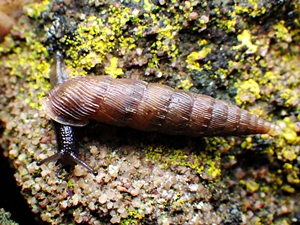 Common door snail (Alinda biplicata): Lambrecht, Rhineland- Palatinate, Germany. Photo: Matthias Buck (iNaturalist). |
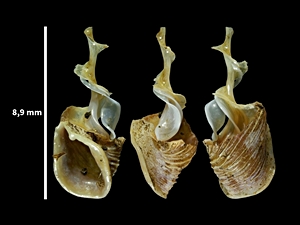 Final shell whorls of Alinda biplicata, laid open. The shell spire (Columella), as well as the Clausilium, are visible. Photo: Mathijs Zonneveld (iNaturalist). |
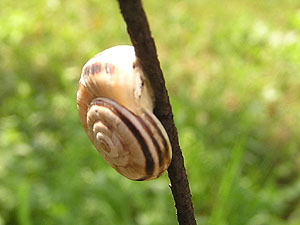 Eastern heath snail (Xerolenta obvia) on a mesh-wire fence in Vienna. Photo: Robert Nordsieck. |
Some species are even better adapted to sunlight and drought: heat-loving (xerophilic) snails of dry habitats, such as heath snails (e.g., Xerolenta obvia) or the zebra snail (Zebrina detrita, Enidae), have white shells, often with dark stripes for camouflage. On warm days, entire roadside bushes can be seen covered with small heath snails resting there in aestivation.
Other gastropods aestivate underground. Slugs, for example, cannot protect themselves with a shell and therefore retreat to sheltered places, often found under boards in gardens. Many slugs also burrow into the soil during dry periods.
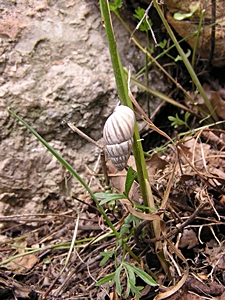 A zebra snail (Zebrina detrita) aestivating on a grass leaf. Photo: Robert Nordsieck. |
![]() Aestivation of the Roman Snail.
Aestivation of the Roman Snail.
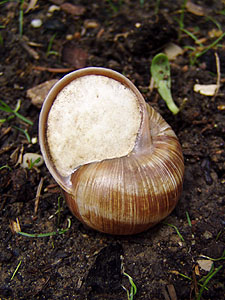 The hibernation lid (epiphragm) not only pro- tects a Roman snail against frost, but also a- gainst desiccation. Photo: Monika Samland. |
They spend the winter in a self-dug burrow, often lined with moss. If the Roman snail also expels excess water and breaks down large unneeded molecules in its bloodstream into smaller components, it can survive frost down to –40 °C without freezing. During hibernation, activity is reduced to the absolute minimum, and even the heartbeat slows drastically.
The epiphragm used for overwintering is probably only secondarily an adaptation to cold, although it does protect against penetrating ice. Roman snails also produce an epiphragm under dry conditions, provided that enough calcium is available.
Their Mediterranean relatives, such as the brown garden snail (Cornu aspersum) or the green snail (Cantareus apertus), form an epiphragm only for protection against dryness, since they do not need to undergo true hibernation in winter in their native home.
A snail goup that benefits from the hibernation of many other snails are the glass snails (Vitrinidae). Those small predatory snails feed on other snails in hibernation. Frosty temperatures do not seem to bother them - they even crawl over snow while hunting.
![]() Hibernation of the Roman Snail.
Hibernation of the Roman Snail.
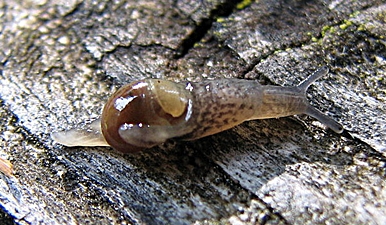 Mountain glass snail (Semilimax kotulae). Photo: Gianbattista Nardi. |
Researchers first observed snail behavior to identify sleep-like states. They found that snails repeatedly entered resting phases of about 20 minutes, during which they were relaxed and showed a markedly reduced response to stimuli—both touch and food. Interestingly, the pond snails did not even retract into their shells during these rest phases.
Land snails also show resting phases that may indicate sleep, though they usually spend them inside their shell to protect themselves against dryness and predators.